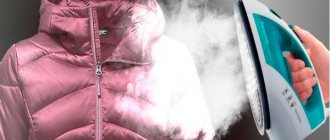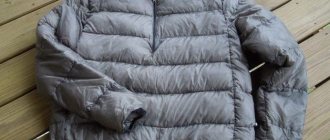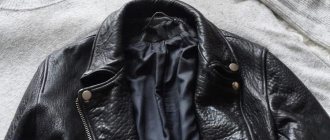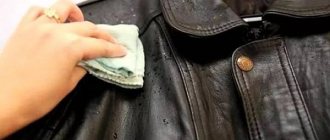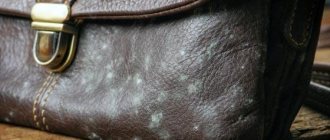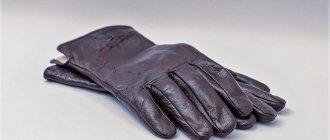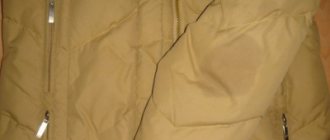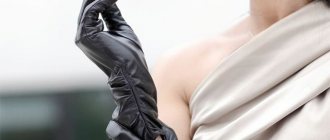Clothes made from genuine leather have many advantages over their artificial counterparts. It “breathes”, looks more attractive, retains heat, and lasts for years. Many people are wondering how to clean a leather jacket at home so that after the procedure its style does not deteriorate and there are no streaks or stains on the surface of the fabric. Before you begin, you should familiarize yourself with the basic methods for removing contamination and the rules for regular maintenance.
How to properly care for a leather jacket
There is essentially no difficulty in caring for a leather jacket. The surface is smooth and easy to clean from dirt. But following the principles for maximum service life is the right approach. It's about following the rules:
- cleaning (daily and unscheduled);
- storage;
- applying products to protect against negative environmental factors.
Such clothes “breathe”, look more attractive, retain heat, and last for years.
The easiest way to care for your favorite wardrobe item is according to the instructions and recommendations from the manufacturer. The main prohibitions are written on the jacket label. For example, recommendations regarding washing or ironing, or storing the product. A leather jacket, with proper care, will last for decades and will not lose its appearance.
Many people wonder how to clean a leather jacket at home without damaging the material.
Nuances of wet processing
Some housewives manage to wash a leather jacket in a washing machine without losing its shape or color. However, manufacturers prohibit any washing of leather items. Intense mechanical stress, high temperature, and unsuitable cleaning products have a bad effect on natural leather. The material deteriorates, quickly wears out, loses its shape, and wrinkles. There is a big risk of damaging your favorite item without returning it.
Wetting the jacket abundantly, much less soaking it for a while, is also not recommended. The main way to quickly clean the entire surface of a jacket is to wipe it with soapy water. To effectively and safely process an item, you must follow the six-step instructions.
- Preparation. Fasten and place the product on a flat surface. If the jacket has fur, unfasten or wrap the fur inserts in plastic so that the soap solution does not get on the fur.
- Preparation of soap solution. Pour warm water into a bowl and rinse a bar of soap in it until foam forms. Prepare a soft sponge and flannel rags.
- Sponge treatment. Wet the sponge with soapy water and wipe the surface of the jacket from collar to hem. Don't apply too much liquid. Contaminated areas can be rubbed a little.
- Rinse. After replacing the soapy water with clean and warm water, rinse your jacket with a rag. Collect excess moisture with a sponge and wipe the product dry.
- Washing the inside. Turn the jacket inside out. Use your fingers to lift the lining, wet it and wash the dirty areas with soap. It is recommended to use a soft brush. Gently rinse the fabric with water and then with a vinegar solution, and blot with a rag. Make sure that the liquid does not come into contact with the leather of the jacket.
- Drying. Turn right side out. Hang the unbuttoned jacket on hangers and dry in an upright position at natural temperature, away from the radiator.
A leather jacket should be washed before storing. It is not recommended to resort to frequent skin washing. If stains of various types have formed on the jacket, it is necessary to remove them locally, without waiting for complete absorption into the skin.
Cleaning a Leather Jacket
You can find out how to clean your skin without causing harm by looking at the label. One of the key tips that will help reduce the amount of cleaning required is to create a moisture-resistant layer. This effect is achieved through the use of special sprays based on silicone or acrylic, wax or fat. But we must not forget about the differences in skin cleansing methods. For most skin types, the cleansing algorithm will be as follows:
- removing stains from the surface;
- collar cleaning;
- tidy up the cuffs and sleeves;
- clean the rest of the surface of the product;
- The lining is cleaned.
Before you begin, you should familiarize yourself with the basic methods for removing contamination and the rules for regular maintenance.
In any case, you should start by removing all kinds of stains. Only after this are the remaining actions performed.
Superficial cleaning
According to the algorithm proposed above, you need to clean the surface of the jacket using a damp cloth/sponge. If contamination turns out to be problematic, it can be removed with soapy water. It is important to thoroughly wipe the surface dry to avoid streaks. The method is suitable for removing simple stains. In any case, after surface cleaning, you need to apply special sprays to give the product a natural shine.
Before washing the entire product, you need to carry out stain removal, as well as preventive care of individual parts of the leather jacket.
Wash
Conventionally, washing a leather jacket can be divided into two main methods: surface (manual) and machine. Dry cleaners clean things more reliably and safely. But even at home, this task is quite feasible. You can wash your jacket in washing machines (if there is no prohibition on this operation on the label), following some rules:
- Mode selection. In any case, you need to choose delicate wash or wool. The mode should be gentle so as not to damage the product.
- Temperature. Leather is a durable material. But it's not worth trying. Therefore, the optimal washing temperature should be around 30 degrees.
- Spin. The safety and integrity of the product depends on the selection of the correct squeezing mode. The spin speed should not exceed 300/min.
- Do not use powders with abrasive materials. They should be replaced with gels and liquid formulations.
If you follow the rules, the quality of cleaning your leather jacket will increase significantly.
You need to finish washing by applying glycerin to the surface. This can only be done when the product is dry.
Note! Hand washing is safer and is recommended instead of machine washing.
Features of leather products
Things made of fabric get dirty faster than leather, but fabric is easier to care for. It is washed and dried, but the leather cannot be washed. Although it repels dirt, care is still needed. Every year, leather products are sent to professional dry cleaning. In between cleanings, this material is wiped down independently.
Cleaning methods depend on the material. Artificial is often not distinguished from natural, there is too much similarity. The origin of the material is determined by certain characteristics:
- The smell inherent in this material.
- Water absorption. The artificial material does not absorb water; it forms a drop.
- The artificial material burns out.
- On the inside, the natural item is suede, while the artificial one is made of fabric or pressed.
- Manufacturers apply markings on real leather.
- The natural material acts like a thermos: it stores temperature.
- The leather is easy to fold, forming folds, and easy to straighten.
Leather items tear easily, and if care instructions are not followed, small cracks appear on the material. They spoil the look and are difficult to disguise.
Traditional methods of cleaning
You don't always want to use chemicals. They are perceived as something radical, which they resort to after futile attempts to get rid of dirt from a leather product. Therefore, folk remedies are in a hurry to help: effective, affordable, using improvised materials. Thanks to traditional methods, you can return the product to its original appearance. Let's look at the most popular of them.
Leather products do not have a wide range of colors, but when cleaning, you should carefully select the products as they can negatively affect the appearance of the jacket.
Rubbing with onion juice
A simple method involving the use of an onion. It must be cut in half so that the juice can be squeezed out. You need to rub those areas that have greasy stains. Press the bulb closer to the surface of the jacket. It is noteworthy that onion juice does not harm the surface. It allows you to add shine.
Onion juice can remove small stains.
Advice! The method, although effective, has its drawbacks. One of these is an unpleasant odor. You can easily eliminate it with a soap solution applied to the surface treated with onion juice.
Egg white treatment
Another effective way to combat stains is egg white. This natural material can be found in almost every household. And you need to apply it according to this algorithm:
- separate the yolk from the white;
- the protein is evenly applied to contaminated areas of clothing (for convenience, use a sponge);
- for the method to work, the proteins must remain on the surface for about 5 minutes;
- Use a damp cloth to remove any remaining protein.
Apply well-beaten egg white to the shiny areas for 1 minute, and then remove with a soft cloth.
The method may not work the first time. But given the fact that it is safe for the skin, you can use it several times until the desired effect is achieved.
Hydrogen peroxide cleaning
The method is not suitable for all surfaces. In particular, it is best used for cleaning white leather jackets (and other white or light-colored items). Peroxide will ruin dark things. The algorithm of actions is simple:
- use a napkin soaked in peroxide;
- we treat contaminated surface fragments;
- The solution is wiped off with a dry cloth.
A cotton swab is soaked in hydrogen peroxide and wiped off greasy stains.
Note! The surface should not be painted, otherwise stains of unknown colors will appear. Restoring the surface is a rather labor-intensive process.
How to clean with dishwashing detergent
Greasy stains are difficult to remove without auxiliary products. In particular, we are talking about a simple method using detergent. The composition of household detergents is designed to combat grease, and therefore cope with complex stains. The action scheme is simple:
- A few drops of detergent are applied to the sponge. For the product to start working, the sponge must be moistened and kneaded to form foam.
- Depending on the degree of penetration of fat into the fabric, leave the foam on the surface for 10-15 minutes. This time should be enough for the product to interact with the contamination.
- The solution is washed off with a damp sponge.
- After the procedure, in order to prevent the material from drying out, you need to moisten it with glycerin or a special spray.
Dishwashing detergent contains a degreaser. A few drops on the stain is enough to remove fresh stains.
Note! The method is quite effective. It is used in the fight against problematic stains in the area of cuffs, pockets, and collars.
Toothpaste
This method can only be used for light and white leather products. The composition of the paste with a whitening effect can remove dirt and dust and help lighten the material. To perform the procedure, you will need a brush with soft bristles, and the paste itself. Carrying out the procedure:
- the paste is applied to the stain with a brush;
- to achieve the optimal effect, the paste needs to be slightly rubbed into the surface;
- if the contamination is too complex, the paste can be left for several hours;
- remove remaining paste with a damp cloth or wet sponge.
Toothpaste with a whitening effect will remove dirt and dust, and also lighten the material, adding brightness and well-groomed appearance to the item.
The dirt should come off without much effort. Natural shine returns.
Important not to apply to black or painted surfaces!
Nail polish remover
Sometimes it happens that all that remains is to apply experimental methods. This includes nail polish remover. It is used in the fight against such serious stains as:
- varnish;
- different types of paints;
- ink.
A white jacket can also be cleaned with nail polish remover, but it is best to use it only as a last resort.
It is important to understand that nail polish remover can permanently damage the surface. That's why it's important to test. This needs to be done on a small area of skin (preferably on the inner surface). If no adverse reaction occurs, then you can safely use it.
Important! The method is relevant for light and white products made of genuine leather.
Baking soda or cornstarch
Use baking soda and cornstarch to make a solution. For it you will need to use 2 tablespoons of soda and starch, per 0.5 liters of water. It is best to heat the liquid to 30-40 degrees so that the components dissolve in it faster. The solution should be used to wash stains using a soft sponge so as not to damage the surface.
Prepare a thick paste from soda or starch by adding a little water.
Medical alcohol
A jar of alcohol will help remove dirt and greasy stains. Being, in fact, a universal solvent, alcohol is able to remove complex stains. It is best to use the product for cleaning light leather products. Sometimes it is possible to use it on dark surfaces, but you need to test it on an inconspicuous fragment. If there is no reaction, you can use the product without fear. From the surface, after cleaning, the remaining solution is removed with a damp sponge.
To remove stains, regular medical alcohol is suitable and should be used to wipe the stain.
Ammonia
In some cases, ammonia works better than medical alcohol. It should be used taking into account the same recommendations as for medical or even solvent or nail polish remover. You need to do this:
- Apply alcohol to a cotton sponge or soft cloth;
- Using rotational movements, remove any remaining dirt;
- wash off the remaining substances from the surface of the jacket with a soap solution;
- hang out to dry.
For shine, you can make a solution that consists of ammonia and warm water in a ratio of ½ and use a soft sponge to wipe the sleeves and cuffs.
An unpleasant odor may remain. But it disappears quickly enough if you hang clothes out for airing. The main thing is to have access to clean air.
Features of removing stains from skin
Dry cleaning at home is the most preferable option. When removing dirt from the surface of a jacket, you must remember that there are various technological methods for dressing and dyeing leather. To add gloss, fixatives and emulsions are used, and pigments are used for tint.
See also
TOP 15 remedies on how to wash a crystal chandelier at home
To avoid coverage damage, you must not:
- apply effort;
- apply aggressive agents for a long time;
- Allow the skin to get completely wet.
Ignoring these conditions will lead to abrasions, deformation, and discoloration.
Minor dirt
When there are no “complicated” stains on the jacket, but only dust and light stains, then it can be washed using a soap solution with ammonia. The soft tissue is wetted in the liquid. The product is wiped completely or in contaminated areas.
The applied foam can be rinsed off in the shower for 10-15 seconds and the item can be wiped dry. After final drying, the leather is softened by applying glycerin, a cream for the care of natural leather.
How to remove greasy marks
Greasy marks in places of frequent contact with the neck, hands, fingers, as well as oily food stains, are removed using special and home remedies. Laundry soap will not help in this case.
It will be effective to treat stained areas with 90% alcohol: apply a moistened piece of cotton wool for a couple of minutes.
Another method is recommended for a fresh stain: place a paper napkin on it, pressing tightly, and heat it with a hairdryer for 3 minutes on medium setting.
How to remove paint marks
The method for removing paint stains depends on the type of paint. Fresh water-based stains are blotted with a napkin and then washed off with warm water until the traces are completely removed. Dried stains are first rubbed off and then removed with a damp sponge.
Depending on the type of paint, solvent, turpentine, or gasoline are used. Apply the product to a piece of cotton wool or a soft cloth and wipe the stain without pressure. The degreased surface is restored by applying glycerin and a skin care product. To remove the smell, you can apply lemon juice and hang it for airing.
How to remove ink
Marks from a ballpoint pen (felt-tip pen) on the skin can be easily treated with medical alcohol. Simply wipe them with a cloth soaked in ethanol.
Salt stains
9% vinegar will help remove salt streaks on your jacket. Apply the moistened cotton wool for 5 minutes, then wipe with clean water.
Blood stains
It is easy to remove fresh traces of blood with cold water and laundry soap. You need to clean the stain from the edge to the center. Dried blood is removed with hydrogen peroxide or acetylsalicylic acid solution. Peroxide should not be used on thin leathers. An aspirin tablet is dissolved in 2 tablespoons of water and applied to the stain with a toothbrush. After 7 minutes, wipe the stain dry.
Professional products
Leather care products can be purchased in stores. Depending on the intended purpose, professional products can be used to perform different procedures. Basically, the end result should be:
- return of natural shine;
- creation of a protective, waterproof layer;
- increasing the service life of the product;
- surface cleaning;
- revitalization of color and others.
For maximum results, any product must first be tested on an inconspicuous area.
Depending on the tasks, a list of necessary products for the care of leather clothing is determined. We invite you to familiarize yourself with professional leather care products.
Water repellent spray
We will not consider ratings of the best sprays, but we will touch on the general principle of operation and rules of use. The purpose of the spray is to penetrate the fabric and form a layer impenetrable to water. It is needed in order to:
- resist the negative effects of direct rays of the sun;
- protection of fabric from fading and loss of color;
- Serves as a barrier to prevent dirt and water from penetrating the skin.
It is recommended to use water-repellent sprays and caring creams more often.
Impregnation provides reliable protection of the material from drying out and weathering. Improves color saturation. Water-repellent sprays can be classified as cosmetics. Their use is relevant for regular surface treatment.
Note! In addition to universal sprays, it is not difficult to find narrowly targeted sprays in stores for a specific type of skin and the characteristics of its surface.
Special sponge
This refers to a sponge impregnated with a special substance based on wax, fat, or other materials. Their structure may be different, depending on the intended purpose. But basically, it is foam rubber of round, oval or square shape, of small thickness. For ease of use, the sponge can be placed on top of the container in which the silicone or wax mixture is located in order to constantly feed it during use.
Special sponges contain components that allow you to properly care for your skin.
Wax
This material is known for its characteristics. In particular, wax can provide a high level of water resistance. It works the same way, regardless of the form in which it is produced (be it a spray or a rub). Thanks to wax you can:
- provide a water barrier and protection from pollution;
- simplify the care of the item;
- make the surface shiny, saturate the shade.
You can soften a leather jacket with wax.
Requires regular use, if not daily, then at least once a week. Wax melts when exposed to elevated temperatures. The film that it forms on the surface of the jacket is quite dense, although unnoticeable.
Foam cleaner
This foam has proven to be quite effective in practice; it has been used (and actively) for more than 10 years. During this time, manufacturers have significantly improved the composition and made it more effective. The whole process comes down to minor manipulations:
- foam is applied to the surface of the jacket in places of contamination;
- Different formulations will require different times to achieve maximum effect;
- The remaining foam is wiped off with a damp cloth or sponge.
Manufacturers recommend foam shampoo for dry cleaning for all skin types.
If the contamination is not completely eliminated, then you will need to repeat the procedure. Since the product is professional, its use does not harm the surface.
Recommendation! Such products need to be selected based on skin type, surface structure and complexity of contamination. The instructions on the product label will help with this.
Cleaning white leather
White leather jackets look very impressive and unusual, because they are very rare. Such leather is actually no different from black or brown, but has a very serious drawback.
On white leather, any dirt will be clearly visible, so you will need to wear such a jacket with caution, cleaning it every time you come home. It is also a good idea to carry out regular care procedures, this will allow the skin to maintain softness.
It is recommended to use milk as a material. It will not leave streaks or stains behind, and its use has a beneficial effect on the condition of the skin, making it softer. Alternatively, you can use lemon juice as it has similar properties.
Rules for washing lining
A jacket can be classified as a category of clothing that is worn every day. This causes negative consequences - greasy surface of the lining. This can cause an unpleasant odor, and aesthetics also suffer. There are two main methods for cleaning the lining of a leather jacket:
- Dry. The most common and simplest method. To implement it, special sprays and foams (professional products) are used. It is quite suitable for removing minor stains.
- Wash. It is necessary if the stains are too deeply embedded in the fabric or the stains are problematic. Washing is acceptable if the lining is detachable. Otherwise, using detergents, clean the inner surface of the product and hang it until completely dry.
During wearing, not only the outer part of the jacket gets dirty, but also the inner lining.
Note! Please read label instructions carefully before machine washing.
How to get rid of greasy
In addition to stains, jackets also have to be cleaned of grease. The following parts of the jacket are often susceptible to such contamination:
- collar lining;
- inner and outer parts of the sleeves;
- pocket area.
Recommendations on how to clean a leather jacket from grease:
- Wipe the area on clothing with a cotton pad or soft sponge soaked in medical alcohol.
- Treat the area with lemon juice or citrus peel.
- Moisten the surface of the product with glycerin and thoroughly knead the jacket.
Wearing a scarf or wiping the area weekly with a sponge soaked in detergent will prevent the collar lining from becoming greasy. It is also recommended to use water-repellent sprays and caring creams more often. To remove stains at any time, you should purchase a ready-made set of products and know how to clean a leather jacket at home.
Wipe with a cotton pad soaked in medical alcohol
Treat the area with lemon juice
Moisten the surface of the product with glycerin
Stretch the jacket thoroughly
How to remove an unpleasant odor
Depending on the source of the unpleasant odor, you need to select methods to combat them. You can eliminate odor using universal methods:
- soap solution with the addition of ammonia;
- place a few tablespoons of coffee in a sealed package with your jacket, limiting the access of oxygen;
- dry cleaning will eliminate even the most persistent odor;
- long-term airing (effective if the item is just lying around);
- professional cleaning products.
Follow these simple tips, and your favorite leather jacket will delight you with its attractive appearance for many seasons to come.
In the fight against persistent odors, it is better to immediately turn to professional cleaning products. They remove dirt, at the same time disinfect the fabric and fight the source of unpleasant odors.
Helpful Tips and Tricks
Frequent degreasing of the leather surface will lead to the destruction of the protective and coloring layer. A detergent used several times a month should be as gentle as possible. For refreshing and removing minor stains, the best remedy is soap solutions. The surface of the jacket is then wiped with a cloth soaked in clean water. Then the emollient is applied and left to dry on a hanger.
You should not wear jackets that are not dry: wet skin will easily stretch, which will lead to the jacket losing its shape. Using a scarf in your wardrobe will eliminate the need to clean your collar from greasy deposits. When dry, leather jackets emit a specific odor, which a few drops of lemon juice will help get rid of.
How to remove stains
Stains of varying degrees of complexity may form on the surface of a leather jacket. Sometimes they can be removed quite easily, but if they have become embedded in the fabric, cleaning them can be problematic. In the fight against stains, professional and folk remedies come to the rescue. Let's figure out how to deal with fresh and old stains in practice.
Fresh
The easiest way to remove stains is as soon as they appear. For example, if we are talking about simple dirt or dust, then it can be easily wiped off with a damp sponge without much effort. The situation is the same with juice, drinks, and low-fat foods. If paint gets on the surface, then the first minutes are decisive: this is the time when the paint, regardless of its composition, can be easily removed with a soap solution, detergent or a damp cloth (especially an alcohol wipe).
Before using the selected product on a visible place on the surface of a leather jacket, try treating a piece of leather in an inconspicuous area.
Obsolete
Contaminants that have become embedded in the fabric are much more difficult to remove. Especially when it comes to ink, paint, oil (machine), fuel oil, etc. In some cases, folk remedies help, for example, ammonia or medical alcohol, nail polish remover, solvent. It is not always possible to eliminate them without the use of special (professional) cleaning products for the care of leather products.
If you can’t deal with the stains on your own, then you should contact a dry cleaner for professional help.
Continuous care
Regular care of a leather jacket does not involve daily cleaning, rubbing and painting - not at all: it is enough just to pay attention to the jacket from time to time in those places where it is most susceptible to contamination. You see that the sleeves, fastener bar, places near the buttons and pockets do not look as we would like - it’s time to take action.
Caring for a leather jacket should be regular: in the future, this will save effort, time and money on restoring the attractive appearance of the product.
The simplest thing you can do is to clean the surface of the jacket from light dirt and dust. The sequence of actions when performing this procedure is as follows:
You will need an ordinary soap solution with a slight addition of ammonia. A soft flannel cloth or non-abrasive sponge is soaked in the resulting solution, and the jacket is treated with gentle, gentle movements over the entire surface or in areas of contamination. After “soaping”, the surface of the leather jacket is washed off with clean running water and wiped dry (do not use excessive physical force - this can stretch and damage the leather). Dry, clean skin is lubricated with castor oil or a special cream intended for natural leather.
This simple cleaning procedure is effective provided that there are no “difficult” stains on the surface of the jacket - it will only refresh the jacket by washing away daily dirt, stains from raindrops, etc.
Grease stains, paint, mold on the jacket
Shiny collars and cuffs or small greasy stains on the jacket can be cleaned with a cotton pad with warm glycerin, makeup remover milk, dishwashing detergent solution, and damp baking soda. Old or large grease stains can be cleaned with a cloth moistened with gasoline, turpentine, alcohol or vinegar. To prevent the jacket collar from getting dirty longer, it is advisable to wear a neckerchief or high-necked clothing underneath.
Gasoline, white spirit, acetone or turpentine will help get rid of paint stains or mold on the skin.
Important! The effect of solvents must first be tested in an inconspicuous place. After treatment, the surface of the dark jacket should be wiped with orange peel, and the light jacket with lemon juice, dried and lubricated with glycerin.
Jackets made of thin leather and leatherette cannot be cleaned with gasoline. Grease stains diluted with water, chalk, talc or starch. A thick paste should be applied to the dirt, left for 15-30 minutes and brushed off with a clothes brush. Lubricate cleansed skin with castor oil.
What to remember
- Remove stains as soon as possible . Fresh stains are much easier to remove.
- Cleanse your skin periodically . Use a simple damp cloth to remove dust.
- If folk remedies don’t help, try special ones . They usually cost from 500 rubles, so it’s easier to try cheap solutions first.
- When using formulations that dry out your skin, moisturize after cleansing . Any nourishing cream will do.
The video shows all the above steps clearly:

